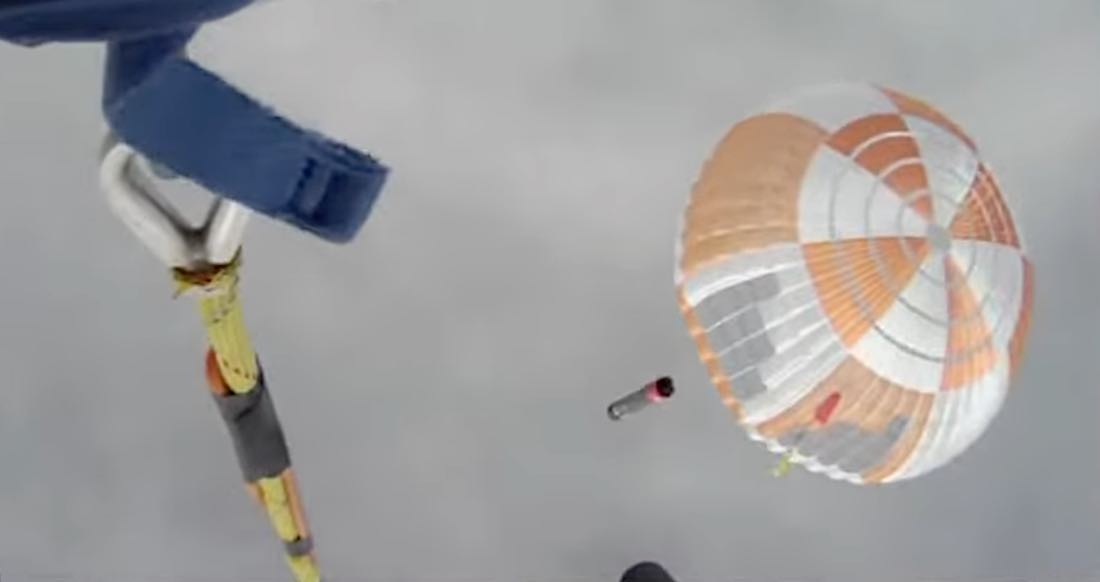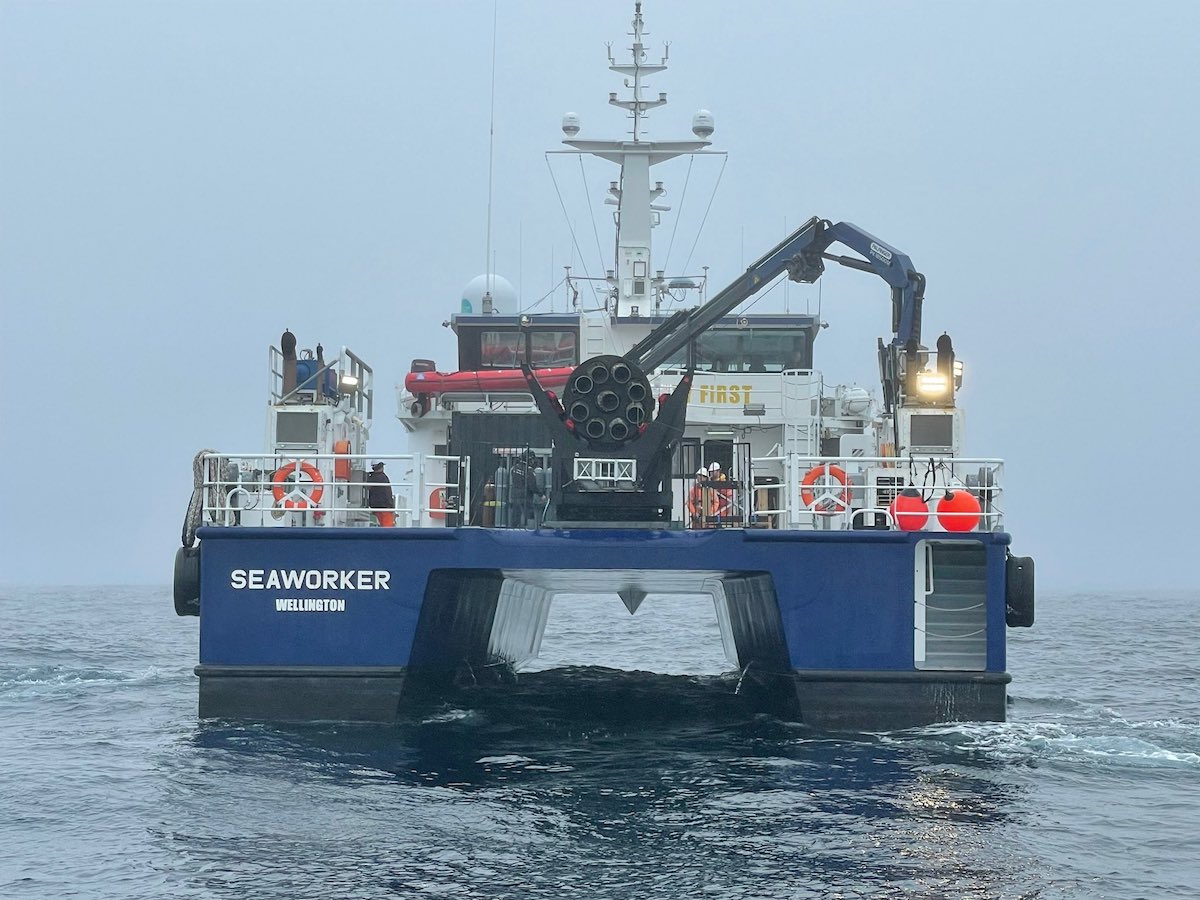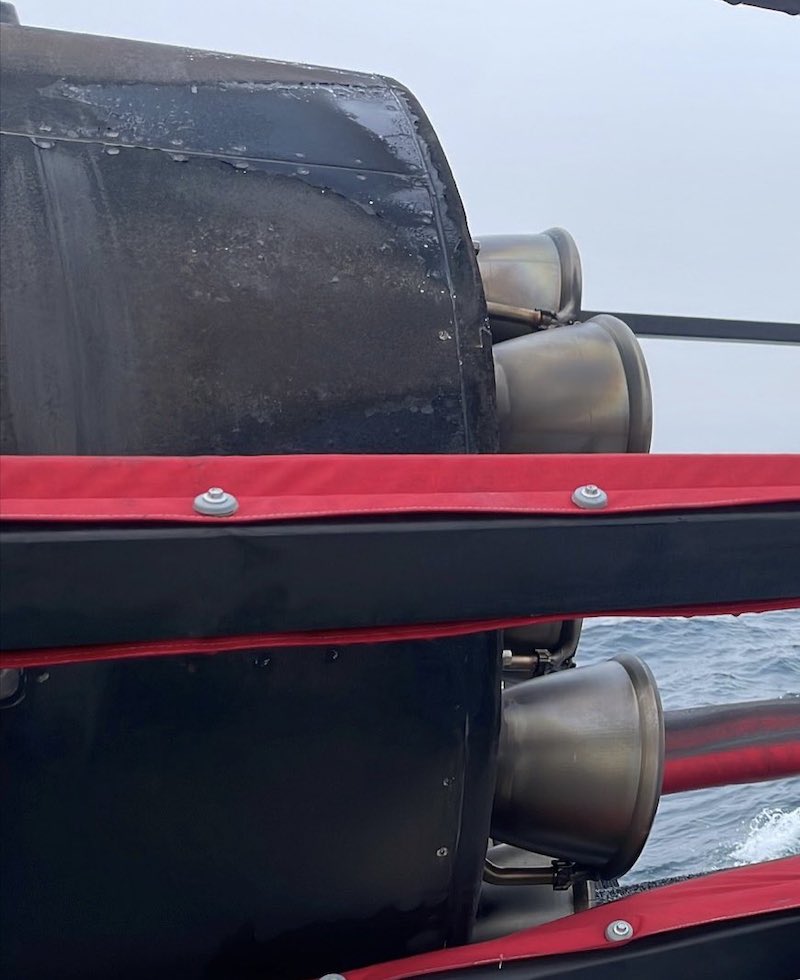
Rocket Lab used a helicopter to capture a spent Electron first stage booster and its parachute after launching satellites from New Zealand Monday, a significant step forward for the company’s rocket recovery and reuse program. The helicopter dropped the rocket a few seconds later.
The rocket splashed down in the Pacific Ocean under its parachute, and Rocket Lab’s recovery ship pulled the booster from the sea. Peter Beck, Rocket Lab’s CEO, said the vehicle was in good shape and didn’t rule out reusing the rocket in a post-flight conference call with reporters.
Rocket Lab intended for the helicopter to deliver the rocket to the deck of the recovery ship — or bring it back to shore — after catching the booster in mid-air. But the pilot decided to release the rocket after encountering “different load characteristics” than experienced during previous tests, the company said.
“Incredible catch by the recovery team, can’t begin to explain how hard that catch was and that the pilots got it,” Beck tweeted. “They did release it after hook up as they were not happy with the way it was flying, but no big deal, the rocket splashed down safely and the ship is loading it now.”
Beck later tweeted several photos showing the 39-foot-long (11.9-meter) carbon fiber booster stage in a cradle on the deck of the recovery ship.
Rocket Lab confirms the recovery helicopter caught the Electron booster over the Pacific Ocean, about 15 minutes after launching from from New Zealand — a major step in the company’s rocket reuse efforts. https://t.co/a8688Hvd0L pic.twitter.com/lMiAJ9gGJf
— Spaceflight Now (@SpaceflightNow) May 2, 2022
The successful mid-air catch of the descending Electron rocket came nearly three years after Rocket Lab announced its plan to recover and reuse first stage boosters.
Before adding the helicopter to the mix, Rocket Lab completed three experimental rocket recoveries from the Pacific Ocean. Those splashdowns under parachutes were experiments designed to gather data on the structural loads, heating, and deceleration the Electron booster encounters during re-entry and descent.
Rocket Lab tested the rocket’s drogue and main parachute designs, demonstrated the use of cold gas thrusters to re-orient the rocket in space, and validated a heat shield to protect the booster and its engines during re-entry.
A customized Sikorsky S-92 helicopter was outfitted to snare the one-ton carbon fiber booster stage suspended under a parachute around 170 miles (280 kilometers) off the coast of New Zealand.
Catching the booster in mid-air prevents it from reaching the ocean, eliminating the risk of hardware corrosion or damage from splashdown in salt water, and easing refurbishment work required to make the rocket suitable to launch again.
The Electron booster is powered by nine kerosene-fueled Rutherford engines. The rocket, standing nearly 60 feet (18 meters) tall on the launch pad, also has a single-engine second stage, and a third stage capable of placing small payloads into orbit.

The mission Monday began at 6:49:52 p.m. EDT (2249:52 GMT) with a successful liftoff from Rocket Lab’s privately-owned spaceport at Mahia Peninsula, located on the eastern shore of New Zealand’s North Island.
The first stage’s nine engines generated more than 50,000 pounds of thrust, guiding the rocket south from Mahia before shutting off its engines and separating from the Electron second stage about two-and-a-half minutes into the flight.
While the second stage ignited to continue the primary mission of delivering commercial satellites into orbit, the booster stage pulsed its control thrusters to fly in a tail first orientation. The booster was expected to reach a top speed of 5,150 mph (8,300 kilometers per hour), then drag and friction slowed the rocket, with external temperatures building up to 4,350 degrees Fahrenheit (2,400 degrees Celsius).
Then a drogue chute and main chute deployed to slow the booster’s descent to about 22.3 mph (10 meters per second). The recovery helicopter swooped in at an altitude of about 6,500 feet (2,000- meters) to snare the rocket’s parachute with a hook positioned at end of a long boom.
The twin-engine Sikorsky S-92 helicopter is a heavy-duty aircraft typically used in oil and gas transport and search and rescue operations. Before trying on a real mission, the helicopter pilots practiced catching inert boosters in a series of drop tests.

Although Rocket Lab didn’t accomplish all of its goals in Monday’s recovery, the entire operation was an experiment. Beck said the company will try again to catch a booster in a few months, following an upcoming mission for NASA that will not include a recovery attempt.
“Bringing a rocket back from space and catching it with a helicopter is something of a supersonic ballet,” Beck said. “A tremendous number of factors have to align and many systems have to work together flawlessly, so I am incredibly proud of the stellar efforts of our recovery team and all of our engineers who made this mission and our first catch a success.
“From here, we’ll assess the stage and determine what changes we might want to make to the system and procedures for the next helicopter catch and eventual re-flight.”
Rocket Lab wants to recover and reuse the first stage from its Electron small satellite launcher to achieve a more rapid cadence of launches, limiting pressure on the company’s factories in Auckland, New Zealand, and Long Beach, California.
SpaceX’s Falcon 9 is the only other operational rocket with a reusable booster stage. The Falcon 9 booster performs propulsive landings on an offshore platform, or at an onshore SpaceX landing pad near the launch site, depending on mission requirements.
Rocket Lab aims to be the second company to achieve booster reusability, a goal the company announced in August 2019. The Electron is much smaller than the Falcon 9, standing about one-quarter the height of SpaceX’s workhorse rocket, with just 1% of the Falcon 9’s payload lift capability.
Rocket Lab’s second stage and kick stage continued into orbit with more than 30 small spacecraft, and successfully injected the payloads into an on-target sun-synchronous orbit about 323 miles (520 kilometers) above Earth.

The payloads included 24 tiny satellites for Swarm Technologies, a company owned by SpaceX which runs a commercial low data rate relay network. Swarm’s “SpaceBEE” satellites are about the size of a slice of bread.
Three demonstration satellites for the startup company E-Space were also launched Monday. The demo sats will test technologies for a planned constellation of small communications spacecraft — which E-Space says could number 100,000 — in low Earth orbit. E-Space is based in the United States and France, and was established by Greg Wyler, founder of O3b Networks and OneWeb.
Rocket Lab also deployed the BRO 6 smallsat for the French company Unseenlabs, which is fielding a maritime and ship surveillance constellation. Aurora Propulsion Technologies, based in Finland, also launched a test satellite named AuroraSat 1 to test a water-based propulsion system for CubeSats.
The mission also launched four small “PocketQubes” in a package for Alba Orbital, a Scottish company. The PocketQubes weighed between 1 and 2 pounds at launch, and included Alba’s Unicorn 2F and three satellites for Acme AtronOmatic, owner of the popular MyRadar weather app.
Acme said the prototype satellites will validate hardware for a planned fleet of small satellites, known as the Hyperspectral Orbital Remote Imaging Spectrometer, or HORIS, constellation.
The HORIS constellation will provide Earth observation data, enhanced by artificial intelligence and machine learning technology, to Acme’s customers and help integrate new services to the MyRadar app, the company said in a press release in March.
Another payload remained attached to Rocket Lab’s kick stage to test an inflatable solar array system for the New Zealand company Astrix Astronautics.
Email the author.
Follow Stephen Clark on Twitter: @StephenClark1.
from Spaceflight Now https://ift.tt/6Oq3h8P
via World Space Info







0 comments:
Post a Comment